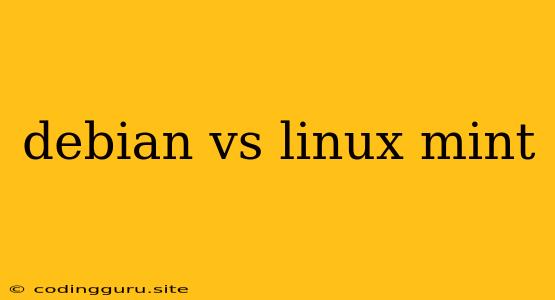Debian vs. Linux Mint: Which Distro Is Right for You?
Choosing the right Linux distribution can be daunting, especially for newcomers. Two popular choices often come up: Debian and Linux Mint. Both offer a user-friendly experience, but they cater to different preferences and skill levels. So, how do you decide which one is better for you? Let's dive into a head-to-head comparison to help you make an informed decision.
What is Debian?
Debian is considered the "mother" of many other Linux distributions. It's a stable and reliable system known for its adherence to open-source principles and a strong focus on security. Its "rolling release" model means continuous updates, so you always have the latest software.
Debian's strengths include:
- Stability: Its rigorous testing process ensures a robust and reliable experience.
- Security: With a commitment to open-source, Debian prioritizes security and regular updates.
- Flexibility: The modular nature of Debian allows for customization and fine-tuning to suit your needs.
However, Debian can be challenging for beginners:
- Steep learning curve: It requires some technical knowledge to navigate package management and configuration options.
- Command-line focused: While graphical environments are available, Debian leans heavily on the command line.
What is Linux Mint?
Linux Mint is a user-friendly distribution based on Debian. It's designed to be accessible to both new and experienced users, offering a familiar desktop experience with popular software pre-installed.
Linux Mint shines in these areas:
- Easy to use: Its intuitive interface, clear menus, and comprehensive documentation make it ideal for beginners.
- Pre-installed software: It includes essential applications like LibreOffice, Firefox, and multimedia players, saving you time and effort.
- Desktop environments: It offers the popular Cinnamon, MATE, and Xfce desktops, providing choices for different preferences.
While user-friendly, Linux Mint might not offer the same flexibility as Debian:
- Less customization: It's more focused on ease of use, limiting some customization options.
- Slightly less frequent updates: It prioritizes stability over the most recent software releases.
Debian vs. Linux Mint: A Quick Comparison
| Feature | Debian | Linux Mint |
|---|---|---|
| Target Audience | Experienced users, developers, and those prioritizing stability | Beginners, casual users, and those seeking a familiar experience |
| Ease of Use | Challenging for beginners | Highly user-friendly |
| Software Availability | Extensive software repositories | Good selection of pre-installed and readily available applications |
| Updates | Continuous rolling updates | More frequent updates |
| Customization | Highly customizable | Limited customization options |
| Desktop Environments | GNOME, KDE, Xfce | Cinnamon, MATE, Xfce |
Choosing the Right Distro
The best choice ultimately depends on your needs and priorities:
- If you prioritize stability, security, and a highly customizable system, Debian is a great option. It's perfect for developers, power users, and those comfortable working with the command line.
- If you value ease of use, a familiar desktop experience, and pre-installed software, Linux Mint is the way to go. It's ideal for beginners, casual users, and those looking for a smooth transition from Windows.
Here's a helpful tip: Consider trying out both distributions using a virtual machine to get a firsthand feel for their interface and functionality before making a decision.
Conclusion
Both Debian and Linux Mint are fantastic Linux distributions. Debian offers a powerful and highly customizable system for experienced users, while Linux Mint provides a user-friendly and accessible experience for beginners. Understanding your needs and preferences will guide you towards the perfect distro for your computing journey.
